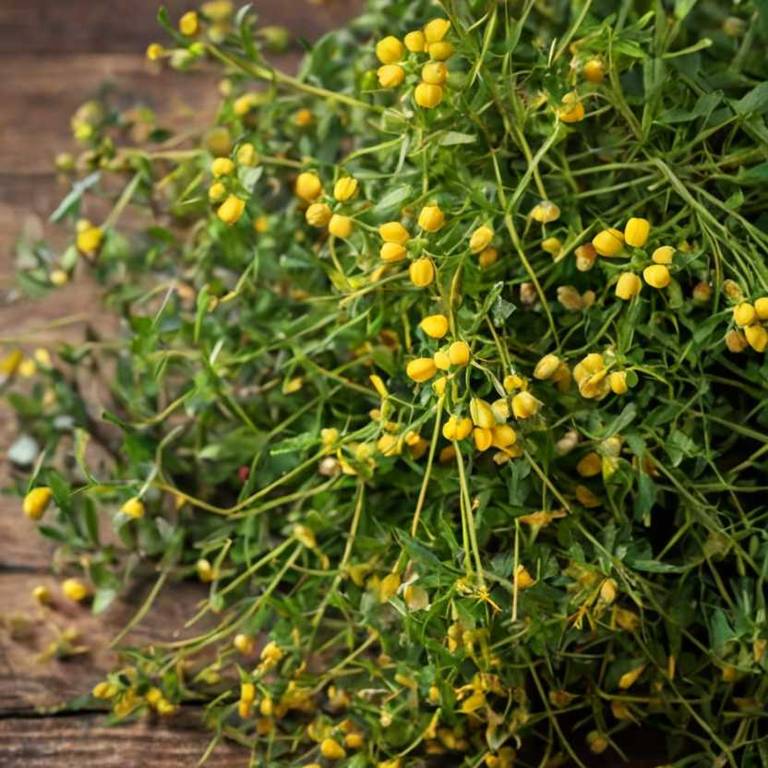By Leen Randell
Updated: Jul 20, 2024
10 Medicinal Constituents Of Hypericum Perforatum (St John'S Wort)

Hypericum perforatum has active constituents such as hyperforin, hypericin, and flavonoids, including rutin, quercetin, and kaempferol.
These constituents exhibit antidepressant, anti-inflammatory, and antioxidant properties. The medicinal properties of st john's wort can improve mood, reduce anxiety and stress, and alleviate symptoms of depression.
The constituents can also enhance cognitive function and improve sleep quality, leading to a better quality of life for individuals suffering from these conditions.
This article explains in details the 10 best active constituents of Hypericum perforatum.
1. Naphthodianthrone
Hypericum perforatum, also known as St. John's Wort, naphthodianthrone is a class of bioactive compounds found in its leaves and stems.
These compounds have been extensively studied for their potential therapeutic properties, including anti-inflammatory, antioxidant, and antimicrobial activities.
The most well-known naphthodianthrone is hyperforin, which has been shown to exhibit antidepressant-like effects and has been used traditionally to treat mild depression and anxiety disorders.
2. Flavonoids
Hypericum perforatum, also known as St. John's Wort, flavonoids is a group of bioactive compounds responsible for its medicinal properties.
These flavonoids, including hyperoside, quercetin, and kaempferol, have been shown to exhibit antioxidant, anti-inflammatory, and antimicrobial activities. They may contribute to the herb's traditional uses in treating mild depression, anxiety, and skin conditions.
Flavonoids also play a role in St. John's Wort's ability to inhibit viral replication and induce apoptosis in cancer cells.
3. Quercetin
Hypericum perforatum, also known as St John's Wort, quercetin is a flavonoid compound found in the plant's leaves and flowers.
It has been traditionally used to treat various conditions, including anxiety, depression, and inflammation. Quercetin has antioxidant and anti-inflammatory properties, which may help alleviate symptoms of these conditions by reducing oxidative stress and inhibiting pro-inflammatory enzymes.
Additionally, it has been shown to have antimicrobial and antiviral activities.
4. Kaempferol
Hypericum perforatum, also known as St. John's Wort, Kaempferol is a flavonoid glycoside isolated from its leaves and flowers.
It exhibits antioxidant, anti-inflammatory, and antiviral properties, making it a potential therapeutic agent for various diseases. Kaempferol has been shown to have neuroprotective effects, improving memory and cognitive function, as well as anti-cancer activities, inhibiting the growth of tumor cells.
Its bioavailability is enhanced by its presence in the plant's leaves, making St. John's Wort an attractive natural source of kaempferol for medicinal applications.
5. Isoquercitrin
Hypericum perforatum, also known as St John's Wort, isoquercitrin is a bioactive flavonoid compound isolated from its aerial parts.
It has been found to possess various pharmacological activities, including anti-inflammatory, antioxidant, and antimicrobial properties. Isoquercitrin has been shown to inhibit the growth of certain cancer cells, reduce oxidative stress, and protect against damage caused by free radicals.
Its potential therapeutic applications include the treatment of skin disorders, cardiovascular disease, and cancer.
6. Aesculin
7. Chlorogenic acid
Hypericum perforatum, also known as St John's Wort, chlorogenic acid is a naturally occurring compound found in its leaves and stems.
It belongs to a class of compounds called phenolic acids and has been extensively studied for its potential health benefits.
Chlorogenic acid has been shown to possess antioxidant, anti-inflammatory, and antimicrobial properties, making it a valuable component of traditional herbal remedies and modern nutritional supplements.
8. Hypericin
Hypericum perforatum, also known as St John's Wort, hypericin is a bioactive compound isolated from the plant.
It is a naphthodianthrone derivative responsible for many of the medicinal properties of Hypericum perforatum.
Hypericin has been shown to exhibit anti-inflammatory, antimicrobial, and antioxidant activities, making it a promising agent in the treatment of various diseases, including depression, anxiety disorders, and skin conditions.
9. Pseudohypericin
10. Adenol
Hypericum perforatum, also known as St John's Wort, Adenol is a compound found in the plant that has been used for centuries to treat various mental health conditions.
It is believed to have a sedative effect and can help alleviate symptoms of anxiety, insomnia, and depression.
Studies have shown that Adenol has a potent inhibitory action on the reuptake of serotonin, a neurotransmitter involved in mood regulation, making it a potential natural remedy for mood disorders.